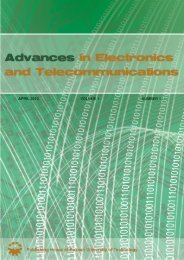november 2010 volume 1 number 2 - Advances in Electronics and ...
november 2010 volume 1 number 2 - Advances in Electronics and ...
november 2010 volume 1 number 2 - Advances in Electronics and ...
You also want an ePaper? Increase the reach of your titles
YUMPU automatically turns print PDFs into web optimized ePapers that Google loves.
44 ADVANCES IN ELECTRONICS AND TELECOMMUNICATIONS, VOL. 1, NO. 2, NOVEMBER <strong>2010</strong><br />
Fig. 1. Real-time ADEV calculation for observation <strong>in</strong>tervals observation<br />
<strong>in</strong>tervals 3τ0, 5τ0, 7τ0 sample <strong>number</strong> 15 is measured.<br />
On-l<strong>in</strong>ecomputationofTDEVismorecomplexthanADEV<br />
computation, especially for the early stages of the process<br />
when the <strong>in</strong>ternal <strong>and</strong> overall sums are computed <strong>and</strong> the<br />
computations for some greater observation <strong>in</strong>tervals are not<br />
active yet (the conditions of beg<strong>in</strong>n<strong>in</strong>g the computations must<br />
be checked for each step). In general, <strong>in</strong> the case of real-time<br />
ADEV computation, three samples are <strong>in</strong>volved for a given n:<br />
onesample currentlymeasured,<strong>and</strong>two samplesfromthe past<br />
– measured n <strong>and</strong> 2n sampl<strong>in</strong>g <strong>in</strong>tervals earlier; <strong>in</strong> the case<br />
of real-time TDEV computation, four samples are <strong>in</strong>volved<br />
(besides these three samples, also the sample measured 3n<br />
sampl<strong>in</strong>g <strong>in</strong>tervals earlier) except for the early stages, when<br />
the <strong>in</strong>ternal sum is updated.<br />
Because the same samples are used for updat<strong>in</strong>g the sums<br />
<strong>in</strong> the real-timecalculation processesof ADEV <strong>and</strong>TDEV, we<br />
could compute both parameters jo<strong>in</strong>tly. The samples needed<br />
for computation of both parameters <strong>in</strong> the current <strong>in</strong>stant can<br />
be read out from the equipment memory at once, us<strong>in</strong>g one<br />
procedure <strong>in</strong>volv<strong>in</strong>g three samples (<strong>in</strong>dexed by i, i − n, <strong>and</strong><br />
i − 2n) at the early stages of the measurement process <strong>and</strong><br />
four samples (additionally the sample <strong>in</strong>dexed by i − 3n) at<br />
the late stages. Therefore, the <strong>in</strong>fluence of the most critical<br />
issue – access to the measured data – on the calculation time<br />
with<strong>in</strong> one sampl<strong>in</strong>g <strong>in</strong>terval can be reduced [7].<br />
An example of the real-time computationof Allan deviation<br />
<strong>and</strong> time deviation for s<strong>in</strong>gle observation <strong>in</strong>terval 3τ0 performedjo<strong>in</strong>tlyispresented<strong>in</strong>Fig.3<strong>and</strong>Fig.4.Theearlystage<br />
ofthe processispresented<strong>in</strong>Fig. 3.Thistime seventimeerror<br />
samples have been measured until now <strong>and</strong> the ADEV sum<br />
operator <strong>and</strong> TDEV <strong>in</strong>ternal sum operator are active, start<strong>in</strong>g<br />
from this <strong>in</strong>stant. The operator of the overall sum Sov(3) is<br />
still not active. Fig. 4 presents the stage of the process after<br />
the sample no. 10 has been measured. The ADEV operator is<br />
active <strong>and</strong> its sum of squares was updated us<strong>in</strong>g samples no.<br />
10, 7, <strong>and</strong> 4. The TDEV <strong>in</strong>ternal operator is not active now<br />
– the sum S(3) is computed now <strong>and</strong> from this <strong>in</strong>stant the<br />
overall sum operator (<strong>in</strong>dicat<strong>in</strong>g four samples) is active – the<br />
first item of the sum Sov(3) can be computed.<br />
Fig. 2. Real-time TDEV calculation for observation <strong>in</strong>tervals observation<br />
<strong>in</strong>tervals 3τ0 <strong>and</strong> 5τ0, sample <strong>number</strong> 16 is measured.<br />
Fig. 3. Jo<strong>in</strong>t real-time ADEV <strong>and</strong> TDEV calculation for observation <strong>in</strong>terval<br />
3τ0, sample <strong>number</strong> 7 is measured.<br />
IV. RESULTS OF COMPUTATION EXPERIMENT<br />
The methodsof separate as well as jo<strong>in</strong>t real-time computation<br />
of ADEV <strong>and</strong> TDEV described above were tested <strong>in</strong> the<br />
calculation experiments. The results of the experimental tests<br />
were presented <strong>in</strong> [6], [7]. The calculations were performed<br />
off-l<strong>in</strong>e but the onl<strong>in</strong>e work was imitated. The data sequence<br />
used <strong>in</strong> the experiment conta<strong>in</strong>s time error samples taken with<br />
the sampl<strong>in</strong>g <strong>in</strong>terval τ0 = 1/30 s, represent<strong>in</strong>g white phase<br />
noise.<br />
The calculations were performed for variable <strong>number</strong>s of<br />
observation <strong>in</strong>tervals, arranged <strong>in</strong> the logarithmic scale <strong>in</strong><br />
a range between 0.1 s <strong>and</strong> 1000 s. The start<strong>in</strong>g (smallest)<br />
observation <strong>in</strong>terval was τm<strong>in</strong> = 0.1 s (n = 3). The longest<br />
observation <strong>in</strong>terval was changed from 1 s till 1000 s. The<br />
calculations were performed for 5, 10, <strong>and</strong> 20 observation







